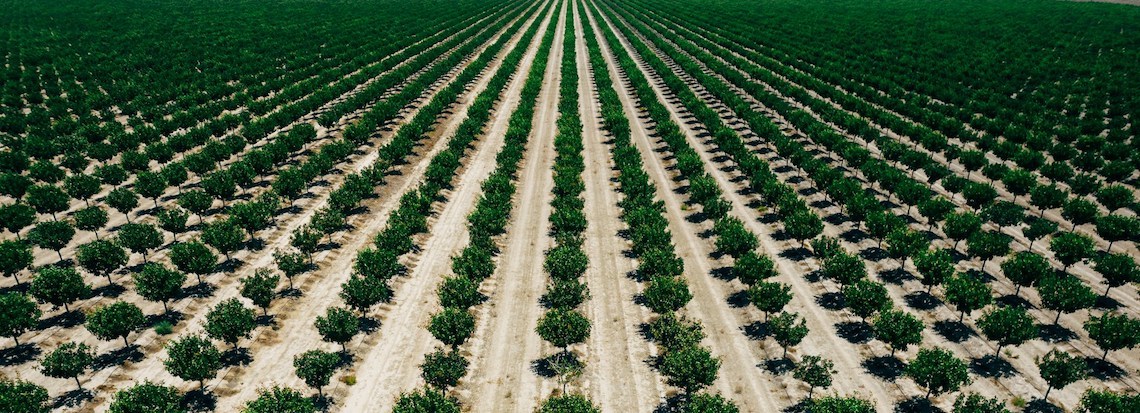
Farm land photo by Karsten Winegeart on unsplash.com
Written by Jeff Macon
After two bruising seasons of low nut prices, rising costs and groundwater uncertainty, the 2025 Trends in Agricultural Land & Lease Values report from the California Chapter of ASFMRA paints a mixed — but not uniformly bleak — picture for the Central San Joaquin Valley. The four counties of Fresno, Kings, Madera, and Tulare (Regions 4 and 5) show continued downward pressure on marginal acres and early signs the market may be finding a floor.
Fresno and Madera counties (Region 4): Water still rules, almonds steadying
- Values have slipped but not collapsed. The authors note a “clearly visible decline” in 2024 listing prices for open land and permanent plantings, especially where parcels lack district surface water.
- Tier 1 districts are holding. Ground that enjoys Fresno Irrigation District (ID), Alta ID or Consolidated ID deliveries remains the most liquid, with almond orchards changing hands between $21,000-$42,000 per acre and a stable value trend.
- Almond demand ticked up. A modest rebound in almond pricing, with buyers cherry‑picking water‑secure blocks, produced “limited but moderate” activity, suggesting prices may have found a bottom.
- Pistachios: limited deals, mostly stable. Mature east‑side orchards with dual water sources clear $25,000‑$30,000/acre, although weaker west‑side ground drags the overall range down to $8,000/acre at the low end.
Kings and Tulare Counties (Region 5): Diverging fortunes by water district
- Water reliability is now the primary value driver. River districts such as Alta ID and Buena Vista WD sit in Tier 1 and white‑land areas with little or no surface supply fall to Tier 4, a spread the report says “significantly enhances” or suppresses values.
- Headline numbers are softer. Almonds fetch $7,500‑$24,000/acre and pistachios $9,000‑$35,000/acre, both labeled “weakening”—yet the study stresses the steepest discounts are for parcels without secure water or with looming SGMA pumping caps.
- Citrus and tree fruit offer a bright spot. Tulare County citrus earns $21,000‑$42,000/acre and is one of the few row‑perennial categories tagged as “stable to slightly increasing.”
- Supply correction underway. Kings, Tulare and Fresno accounted for 30 percent of statewide almond removals last year, a painful shake‑out expected to “find a better balance” between supply and demand.
Cross‑county signals of cautious optimism
- Commodity turnaround. All three major nut crops posted price gains in late 2024. Growers are hopeful pricing continues to firm, the report notes. Even walnuts, long in the doldrums, generated “a small profit” for some operators last season.
- SGMA clarity is improving underwriting. With 86 of 93 Valley subbasins now operating under approved sustainability plans, lenders and buyers have a clearer — if still tough — playbook for evaluating long‑term water budgets, replacing the uncertainty discount with risk‑based pricing. As PPIC water‑policy director Ellen Hanak reminds growers in the California Farm Bureau Ag Alert, “The law doesn’t say you have to end overdraft overnight. You can get there gradually over the 20 years — so long as you avoid ‘undesirable results’ along the way.”
- Best‑in‑class ground remains a haven. Across both regions, parcels enjoying senior surface rights or proven recharge projects command the Valley’s highest bids and shortest marketing periods.
- Input relief for dairies. Stable feed costs and consolidation into water‑secure basins allowed many producers to remain cash‑flow positive in 2024, slowing the pace of facility liquidations.
Outlook: a market in transition, not free‑fall
The ASFMRA team sums up 2024 as “buyers sharpening their pencils” while sellers “become more realistic,” a gap rapidly narrowing toward new, lower but healthier equilibrium pricing. For growers and investors in Fresno, Kings, Madera and Tulare counties, the message is clear:
— Secure water is worth the premium.
— Commodity rebounds are breathing life into Tier 1 orchards.
— Strategic orchard removals and a resilient dairy/citrus base give the region a platform for recovery.
While 2025 will still demand belt‑tightening and rigorous due diligence, the Trends report suggests the area’s core assets are bending, not breaking — perhaps the first real dose of optimism.







